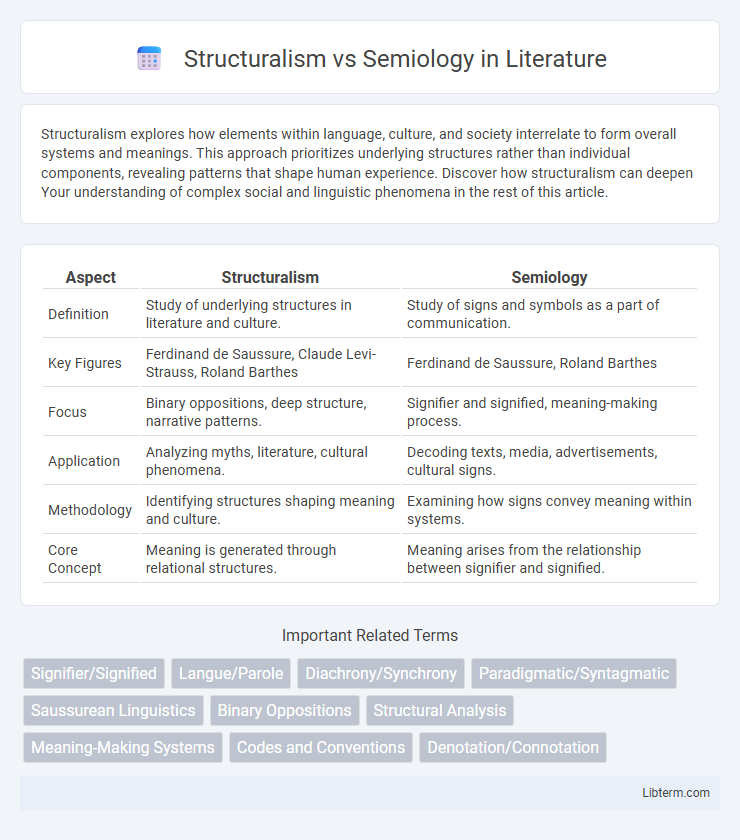Structuralism explores how elements within language, culture, and society interrelate to form overall systems and meanings. This approach prioritizes underlying structures rather than individual components, revealing patterns that shape human experience. Discover how structuralism can deepen Your understanding of complex social and linguistic phenomena in the rest of this article.
Table of Comparison
| Aspect | Structuralism | Semiology |
|---|---|---|
| Definition | Study of underlying structures in literature and culture. | Study of signs and symbols as a part of communication. |
| Key Figures | Ferdinand de Saussure, Claude Levi-Strauss, Roland Barthes | Ferdinand de Saussure, Roland Barthes |
| Focus | Binary oppositions, deep structure, narrative patterns. | Signifier and signified, meaning-making process. |
| Application | Analyzing myths, literature, cultural phenomena. | Decoding texts, media, advertisements, cultural signs. |
| Methodology | Identifying structures shaping meaning and culture. | Examining how signs convey meaning within systems. |
| Core Concept | Meaning is generated through relational structures. | Meaning arises from the relationship between signifier and signified. |
Introduction to Structuralism and Semiology
Structuralism analyzes cultural phenomena by uncovering underlying systems and relationships, focusing on structures that govern meaning within language, literature, and social practices. Semiology, established by Ferdinand de Saussure, specifically studies signs and symbols as part of a language system, emphasizing the signifier-signified relationship to decode meaning. Both approaches share a goal of understanding meaning through deep structural analysis but differ in scope, with Structuralism extending beyond linguistics to broader cultural systems.
Historical Origins and Key Thinkers
Structuralism, emerging in the early 20th century, was primarily shaped by Ferdinand de Saussure's linguistic theories, emphasizing the underlying structures governing language and culture. Semiology, a branch of structuralism, developed from Saussure's work and was popularized by Roland Barthes, who expanded its application to various sign systems beyond language, exploring signs, symbols, and their meanings. Both approaches share a focus on the relational nature of signs, but structuralism concentrates on universal structures, while semiology investigates the specific cultural signification processes.
Fundamental Concepts of Structuralism
Structuralism is centered on the idea that elements of human culture must be understood in terms of their relationship to a broader system or structure, emphasizing binary oppositions and deep underlying patterns. Fundamental concepts include the distinction between langue (the abstract system of language) and parole (individual speech acts), the notion of synchroneity (studying elements at a specific point in time), and the role of signifiers and signified in creating meaning. Structuralism seeks to uncover the universal structures underpinning cultural phenomena, contrasting with semiology's broader focus on signs in communication and meaning-making processes.
Core Principles of Semiology
Semiology, rooted in the study of signs and symbols, centers on the triadic relationship between the signifier, signified, and the sign, establishing meaning through arbitrary social conventions. Structuralism emphasizes underlying structures in cultural phenomena, treating elements as part of a system governed by binary oppositions. Semiology's core principles analyze how meaning is constructed through sign systems, highlighting the fluidity and contextual nature of interpretation beyond fixed structural rules.
Language and Meaning in Both Theories
Structuralism views language as a system of interrelated signs where meaning arises from the differences and relationships between elements within the linguistic structure. Semiology, founded by Ferdinand de Saussure, emphasizes the study of signs (signifier and signified) and how meaning is produced through the arbitrary but socially agreed connections between them. Both theories analyze language as a code that generates meaning through the dynamic interplay of signs within a structured framework.
Structural Analysis vs. Semiological Interpretation
Structural analysis examines the underlying systems and relationships within a text or cultural artifact, emphasizing how elements function collectively to produce meaning. Semiological interpretation focuses on decoding signs and symbols by exploring their signifiers and signifieds within specific cultural contexts. While structural analysis reveals the frameworks shaping meaning, semiology delves into the nuanced interpretations of signs embedded in communication.
Influences on Literary and Cultural Studies
Structuralism and Semiology both significantly influence literary and cultural studies by providing tools for analyzing texts and cultural artifacts through underlying structures and sign systems. Structuralism, rooted in linguistics and anthropology, emphasizes the identification of universal patterns and binary oppositions that shape narratives and cultural phenomena. Semiology, developed by Ferdinand de Saussure, focuses on the study of signs and symbols as components of meaning-making processes, enabling scholars to interpret cultural codes and the relationship between signifiers and signifieds.
Critiques and Limitations
Structuralism faces critiques for its rigid emphasis on underlying systems, often neglecting historical and cultural context, leading to overly deterministic interpretations. Semiology, while expanding focus to signs and symbols, is limited by its abstract nature, sometimes failing to account for pragmatic language use and social dynamics. Both approaches struggle with accommodating individual agency and fluidity in meaning, which restricts their application in diverse communicative environments.
Legacy and Contemporary Relevance
Structuralism laid the foundation for understanding cultural phenomena through underlying structures and binary oppositions, profoundly influencing linguistics, anthropology, and literary theory. Semiology, as developed by Ferdinand de Saussure, expanded this legacy by formalizing the study of signs and sign systems, directly shaping contemporary semiotics, media studies, and communication theory. The ongoing relevance of both frameworks is evident in their application to digital media analysis, branding strategies, and the interpretation of cultural narratives in modern interdisciplinary research.
Conclusion: Bridging Structuralism and Semiology
Bridging Structuralism and Semiology reveals that both frameworks prioritize understanding underlying systems that shape meaning, with Structuralism focusing on the relationships within structures and Semiology examining signs and symbols as communicative units. Integrating these approaches enhances the analysis of language, culture, and media by highlighting how signifiers function within structural contexts to produce meaning. This synthesis offers a comprehensive model for decoding complex cultural texts and social phenomena through interconnected patterns of signification.
Structuralism Infographic

 libterm.com
libterm.com